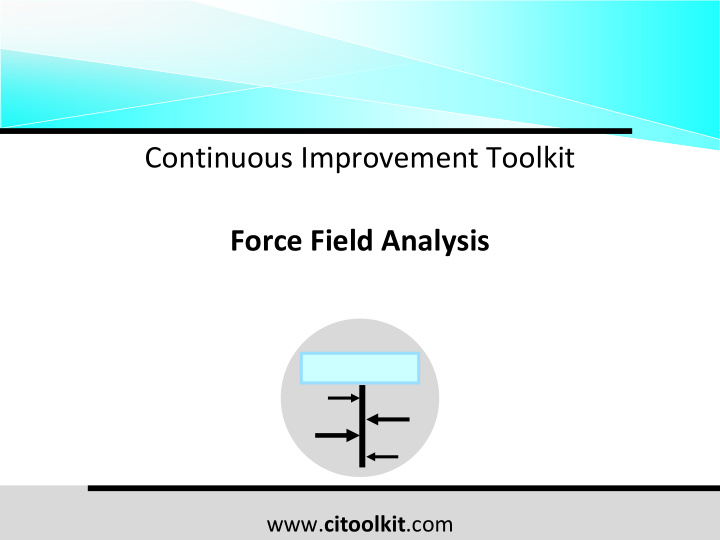



Continuous Improvement Toolkit Force Field Analysis www. citoolkit .com
The Continuous Improvement Map Managing Selecting & Decision Making Planning & Project Management* Risk PDPC Daily Planning PERT/CPM Break-even Analysis Importance Urgency Matrix RAID Log* Quality Function Deployment Cost Benefit Analysis MOST RACI Matrix Activity Networks FMEA Payoff Matrix Delphi Method TPN Analysis Risk Analysis* SWOT Analysis Stakeholder Analysis Decision Tree Pick Chart Voting Four Field Matrix Fault Tree Analysis Project Charter Improvement Roadmaps Critical-to X Force Field Analysis Portfolio Matrix Traffic Light Assessment PDCA Policy Deployment Gantt Charts Paired Comparison Decision Balance Sheet Kano Lean Measures DMAIC Kaizen Events Control Planning OEE Prioritization Matrix Pugh Matrix Cost of Quality* Standard Work Document control A3 Thinking Process Yield Matrix Diagram Project KPIs Pareto Analysis KPIs Implementing Best Practices Understanding Capability Indices Nonparametric Solutions*** Descriptive Statistics Chi-Square TPM Automation Cause & Effect Gap Analysis* Hypothesis Probability Distributions Mistake Proofing Health & Safety ANOVA DOE Bottleneck Analysis Histograms Multivariate Normal Distribution Simulation Just in Time 5S Multi-vari Studies Reliability MSA Graphical Methods Scatter Plots Quick Changeover Visual Management Correlation Regression Understanding 5 Whys Run Charts Product Family Matrix Flow Pull Root Cause Analysis Data Mining Performance** Control Charts SIPOC* Spaghetti** Process Redesign Fishbone Diagrams Relations Mapping Benchmarking*** Waste Analysis** Value Stream Mapping** How-How Diagram*** Tree Diagram* Sampling Data collection planner* Brainstorming Attribute Analysis Value Analysis** Process Mapping SCAMPER*** Check Sheets** Interviews Affinity Diagrams Morphological Analysis Flow Process Charts** Time Value Map** Questionnaires Focus Groups Data Mind Mapping* Lateral Thinking Flowcharting IDEF0 Service Blueprints Observations Collection Group Creativity Designing & Analyzing Processes Suggestion Systems Five Ws www. citoolkit .com
Force Field Analysis A decision making technique that can be used to analyze the Pros and Cons of any decision www. citoolkit .com
Force Field Analysis It looks at the forces that are either driving or blocking movement toward a goal DECISION Forces Forces against for www. citoolkit .com
Force Field Analysis Better decisions are made by weighing up the pros and cons, then determining the force that will win! www. citoolkit .com
Force Field Analysis This technique is widely used in the fields of: Organizational Business Social and change and process cultural development management sciences www. citoolkit .com
Force Field Analysis Uses . . . To analyze the pros and cons of any organizational decision When decision making isn’t going well To explain the reasons behind the taken decision www. citoolkit .com
Force Field Analysis Benefits By analyzing both the helping and the hindering forces, decision makers can make more intelligent business decisions in a team-oriented manner www. citoolkit .com
Force Field Analysis Examples of Uses Deciding whether to move ahead with a change proposal or not Deciding whether to employ an internal or an external consultant www. citoolkit .com
Force Field Analysis How to Construct a Force Field Diagram Gather the team. Involve experts where appropriate Describe the decision that needs to be made www. citoolkit .com
Force Field Analysis How to Construct a Force Field Diagram Write the decision in a box at the top middle of a paper or white board DECI SI ON www. citoolkit .com
Force Field Analysis How to Construct a Force Field Diagram Draw a line from the box down the middle of the paper DECI SI O N www. citoolkit .com
Force Field Analysis How to Construct a Force Field Diagram List all possible helping forces left to the line List all possible hindering forces right to the line DECI SI O N Each argument or force could be shown in an arrow www. citoolkit .com
Force Field Analysis How to Construct a Force Field Diagram Allocate a numerical score to each force indicating its significance (e.g. from 1 to 5) DECI SI O N 5 2 3 4 1 2 www. citoolkit .com
Force Field Analysis How to Construct a Force Field Diagram Add up the scores of both lists to find out which force wins DECI SI O N 5 2 Actions should be 3 4 taken where forces are 1 2 greater 9 8 www. citoolkit .com
Force Field Analysis Questions to Help Identify the Forces Involved What are the benefits ? What are the costs ? What is the best or worst thing that could? How easy or difficult will it be to implement ? How long it will take? How could it fail ? What must we do to make it work? www. citoolkit .com
Force Field Analysis Example – Implementing a content management solution Implementing a content management solution 4 3 Helps in implementing change Likely to face huge resistance 4 3 Makes it easy to share documents The cost is high 3 2 Supports process automation Difficult to measure the benefits 2 2 Lack of technical expertise A cloud solution is available www. citoolkit .com
Force Field Analysis Example – Employing an internal over an external consultant Employing internal consultants over external ones 5 3 Not exposed to best practices Familiarity with the organization 3 3 Protecting privacy Difficult to recruit candidates 1 1 Potential senior managers Likely to face size reductions 5 1 Difficult to accurately measure The cost is significantly less the true costs and benefits www. citoolkit .com
Force Field Analysis Further Information It’s important to identify as many of the factors as possible The length or thickness of each arrow may indicate the weight of the force www. citoolkit .com
Force Field Analysis Further Information Care should be taken for factors relating to environment, health and safety www. citoolkit .com
Recommend
More recommend